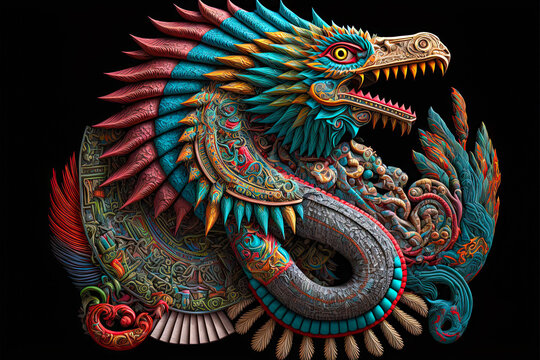Quetzalcoatl

Quetzalcoatl, the enigmatic and revered deity of Mesoamerican mythology, stands as a testament to the rich cultural tapestry woven by the ancient civilizations of Mexico and Central America. Often depicted as a feathered serpent, Quetzalcoatl played a central role in the belief systems of cultures like the Aztecs, Maya, and Toltecs. This mystical figure, with its complex history and enduring legacy, continues to captivate the imagination and serves as a symbol of the profound spiritual connection these civilizations had with their natural surroundings.
Origin and evolution of Quetzalcoatl
The name “Quetzalcoatl” is derived from Nahuatl, the language of the Aztecs, and translates to “feathered serpent.” Although Quetzalcoatl’s mythology is most closely associated with the Aztecs, its roots can be traced back to earlier Mesoamerican civilizations. The Olmec people, one of the earliest Mesoamerican cultures, are believed to have laid the foundation for the Quetzalcoatl myth.
Over time, Quetzalcoatl’s image evolved, and different civilizations incorporated their own interpretations and attributes into the deity’s identity. In the Aztec pantheon, Quetzalcoatl was a complex figure associated with creation, fertility, and wisdom. He was often depicted with the head of a serpent adorned with vibrant feathers, symbolizing his connection to both the earth and the sky.
Quetzalcoatl in Aztec beliefs
Among the Aztecs, the creature held a prominent place in their religious cosmology. He was considered one of the principal gods, alongside deities like Huitzilopochtli (the god of war and the sun) and Tlaloc (the god of rain and fertility). Quetzalcoatl represented a counterbalance to Huitzilopochtli’s warlike attributes, emphasizing a more peaceful and nurturing aspect of existence.
One of the most intriguing aspects of Quetzalcoatl’s mythology is the belief that he was responsible for creating humanity. According to Aztec cosmogony, Quetzalcoatl and his divine counterpart Tezcatlipoca sacrificed themselves to give birth to the world and humanity. This notion of self-sacrifice underscored the importance of balance and harmony in the Aztec worldview.
Quetzalcoatl was also associated with agricultural abundance and fertility, as his role in nurturing humanity extended to providing sustenance from the earth. His benevolence was celebrated through various rituals, including the famous Feast of Quetzalcoatl, a festival dedicated to this revered deity.
The downfall of Quetzalcoatl
The Quetzalcoatl myth also incorporates elements of tragedy and human imperfection. According to legend, Quetzalcoatl was driven into exile after succumbing to temptation and breaking his vows of celibacy. During his period of self-imposed exile, he left the Aztecs with a prophecy – he would return in the future, heralding a new era of peace and prosperity.
This prophecy set the stage for the arrival of Spanish conquistadors in the early 16th century. The Aztecs, under the leadership of Moctezuma II, initially believed the Spanish conquistador Hernán Cortés to be the returning Quetzalcoatl. This misunderstanding played a significant role in the eventual fall of the Aztec Empire, as Cortés and his forces exploited the situation to their advantage.
Legacy and cultural significance
Quetzalcoatl’s legacy extends far beyond the realm of mythology and religion. The imagery of the feathered serpent has left an indelible mark on Mesoamerican art, architecture, and symbolism. Temples, pyramids, and other structures were often adorned with serpentine motifs and feathers to honor this deity.
Furthermore, Quetzalcoatl continues to be celebrated in contemporary Mexico through festivals, such as the Fiesta de Quetzalcoatl in Teotihuacan, where people pay homage to this ancient god with dances, music, and reenactments of ancient rituals.
Quetzalcoatl, the feathered serpent of Mesoamerican mythology, represents the profound connection between nature, spirituality, and humanity in the ancient civilizations of Mexico and Central America. The evolution of Quetzalcoatl’s mythology and its incorporation into various cultural aspects reveal the depth of Mesoamerican belief systems.
Though the fall of the Aztec Empire brought an end to the worship of Quetzalcoatl as a deity, the legacy of this mythical figure lives on in the hearts and minds of people across the world. As we explore the intricacies of Quetzalcoatl’s story, we gain a deeper appreciation for the rich cultural heritage of Mesoamerica and the enduring power of mythology to shape our understanding of the past and present.
